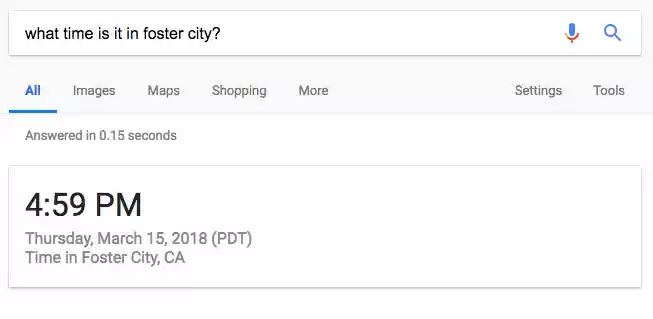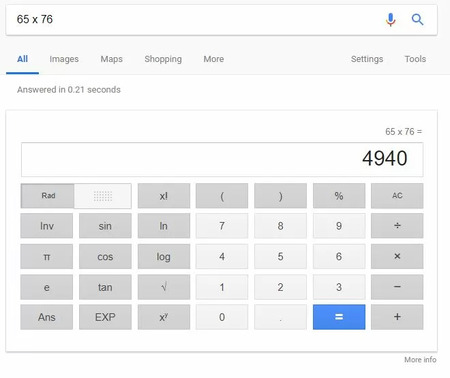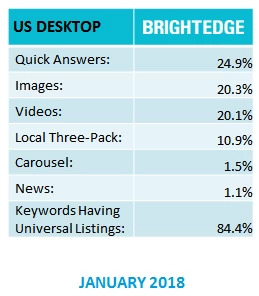3/22/2018 Update: Google's test of question-answer SERPs is now officially on hold. Danny Sullivan stated that, in response to a week's worth of data and user feedback, Google is concluding the experiment and looking at "improving when and how it appears," suggesting the question-answer SERP could reappear in the future in a re-optimized format.
Update! We have enough data and feedback -- which is appreciated -- to conclude that the condensed view experiment should stop for now. The team will look at improving when and how it appears.
— Danny Sullivan (@dannysullivan) March 20, 2018
Google is testing a new type of "question-answer SERP" that shows just one answer for a basic query. This is another evidence that Google is making search a helpful and personalized utility to help each search user as immediately as possible. However, marketers do not have to worry about immediate negative impact to their search efforts.
What is happening? Stop and think about it. When someone asks you a question you don't provide a menu of ten answers framed with extra visual content at the top and on the right. You just pick the best answer and reply, and if you are unsure, you might use "It depends" as a way to collect more specific information. It is a logical evolution of artificial intelligence (AI) that Google and its RankBrain algorithm are so confident in interpreting some search queries that they provide just a single result. In a sense this is Google being helpful and providing the user the answer in the quickest and most direct method possible. This week Google started a large-scale experiment where they show a single answer for a simple query like, "what time is it."  Another type of question-answer SERP is for temperature, and another comes up for calculating the results of a mathematical query.
Another type of question-answer SERP is for temperature, and another comes up for calculating the results of a mathematical query. 
What does this mean to you? As usual, BrightEdge synthesizes industry trends and provides context and perspective to help our community of SEOs and digital marketers explain new phenomena like this. Because this kind of one-result SERP typically are presented for search queries which are purely informational in nature, we expect there will not be a dramatic drop in Impressions, Clicks or Position for marketers. For most marketers, these are the type of keywords you either do not currently rank for, or do not want to focus your efforts creating content for.
How is the SERP evolving? Let's zoom out a bit and look at the broader picture. Universal SERP elements are increasingly present in search results. BrightEdge Research found that 84.4% of SERPs in January 2018 had at least one universal results SERP element. When these results are ads, all organic results are pushed further down to the fold. When the universal results link to Google assets, this also reduces the opportunity for organic traffic. BrightEdge Research has counted more than 40 different Universal SERP elements but 6 types make up 79% of that 84.4%.  So, the other 34 SERP elements make up about 5% and are unlikely to have a commercial impact on the BrightEdge Community. So while interesting to observe it doesn't change workflow or approach.
So, the other 34 SERP elements make up about 5% and are unlikely to have a commercial impact on the BrightEdge Community. So while interesting to observe it doesn't change workflow or approach.
How do you handle this change? BrightEdge has developed what we call visual parsing technology, to help our customers understand each content type that is occurring for every single keyword. Thinking about keywords in 40 SERP types is not realistic, so we recommend organizing keyword opportunities into 4 main buckets: Defend, Optimize, Create, and Collaborate. The main difference between each bucket is looking at if there is organic content above the fold and is your content above the fold.
BrightEdge has created a StoryBuilder template to help customers organize around this structure with its Intent Signal Dashboard. Intent Signal analyzes if a keyword has any organic listing above the fold (by Desktop, Tablet or Smart Phone) and whether you have content shown above the fold for that keyword. This insight helps you refine the optimization work plans for the most valuable keywords you are trying to optimize or create content. Log in to your BrightEdge account, go to StoryBuilder, click on the templates icon (which is to the left of the edit pencil) and select Intent Signal Dashboard. In closing, content marketing and SEO needs to be guided by where the return of traffic promises to outweigh the costs of creating content to target it. Understanding the SERPs and prioritizing keywords is the best way to intelligently develop and deploy your content assets for your audience. Learn more about SERPs and universal SERP elements in this post.


